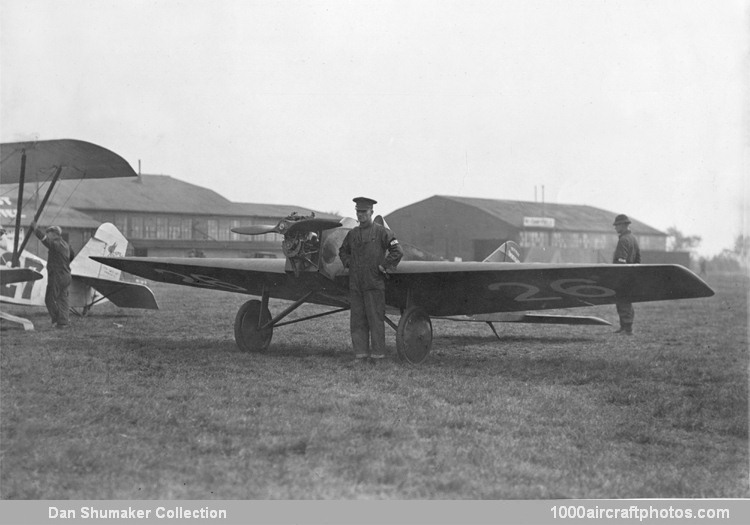The 1924 Sport-plane was quite different from his earlier efforts, which had featured streamlined wood monocoque fuselage construction, and was apparently designed more for structural simplicity and good pilot visibility. It was an airplane of unusual design for 1924, a cantilever low-wing type, of all-wood construction, with a wide-tread landing gear. The fuselage was of a rectangular cross section with plywood covering. No stabilizer was used, as the fuselage extended aft full-width to a horizontal knife-edge. A single-piece "flying tail" elevator was installed, with a conventional fin and rudder. The thick cantilever wood wing used the Curtiss 35B airfoil at the root, tapering to a much thinner section at the tip. It had a split-axle landing gear. These features gave it a smart and up-to-date appearance.
It was powered with an 18 hp 74 cu.in (1.21 l) Harley-Davidson motorcycle engine. The Sport-plane was first flown with a direct drive to a small propeller, but to improve the take off this was soon changed to a chain-drive reduction gear driving a larger propeller.
In 1923 and 1924 the English lightplane races had received much publicity and aroused interest in low-powered airplanes. At the Dayton Air Meet held in October 1924, the first lightplane races of national scope were held in this country. There were three events open to airplanes with engines of less than 80 cu.in (1.31 l) of displacement, and under the racing number 75 Mummert entered his Sport-plane in all three events.
The first event was a 25 mls (40 km) race for the Dayton Daily News Trophy, which was won by Jimmie Johnson flying the Driggs Johnson DJ-1 monoplane. Mummert was forced out of the race after two laps due to engine failure.
The second lightplane race, 50 mls (80 km) for "speed and efficiency", was won by Mummert; however, he again had a forced landing due to a broken valve spring. Mummert replaced his valve spring with one taken from a motorcycle owned by George Edwards, who had ridden it all the way from New York City to see the races. Mummert was then able to take off again and finish the race in first place with an average speed of 38 mph (61 kmh). All the other airplanes were still on the ground due to either engine trouble or excessively rough air.
The third event was a 140 mls (225 km) cross-country race for the Rickenbacker Trophy, which was won by E. Dormoy in his Flying Bathtub. Mummert was consistent in having engine trouble, which again forced him to withdraw about 20 mls (32 km) from the start.
The 1925 National Air Races were held at Mitchell Field, Long Island, and again Mummert entered his Sport-plane in the three lightplane events under the racing number 26. However, he was unable to place in any of the races, all three lightplane races were won by the Bristol Cherub-powered Powell racer.
After the 1925 National Air Races, Mummert advertised the Sport-plane for sale for $850 complete, or $750 less engine. It was sold in 1927 to Homer W. Goodier, an engineer from Solvay, New York. Goodier spent about two years overhauling and rebuilding the ship and installed a six-cylinder Anzani engine. The airplane was taken to the Amboy Airport near Syracuse, New York, after being registered as the Mummert Sport-plane (registration 520K, c/n 3). Goodier had learned to fly during WW I but had not flown since the war. He was checked out at the Amboy Airport and eventually took the Mummert Sport-plane to his brother's farm near Sauquoit, New York, where he flew it for some time. On the evening of August 6, 1930, while flying from the farm field, Goodier was killed when the ship spun in from an altitude of about 300 feet and was totally demolished.
In late 1924 Mummert left the Curtiss company on Long Island and became chief engineer for the Aerial Service Corporation in Hammondsport, New York. This company later became Mercury Aircraft Inc., and Mummert remained there, responsible for a number of interesting airplane designs, until his death in 1939."
